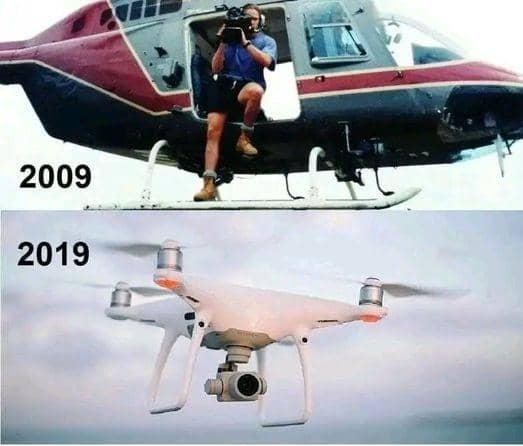The introduction of drones into the film industry ushered in a new era of filmmaking. Before the era of 2010, camera drones were not available, and the pilot and the cameramen felt like Gods who could make the aerial flight videos. In less than 10 years, drones replace workers in the movie industry, let us see how in details below.
Summary of How Drones Have Replaced Workers in the Movie Industry.
- Drones are cost-effective aerial shots: Drones can capture high-quality aerial shots at a lower cost compared to traditional methods using helicopters.
- Increased versatility: Drones can easily maneuver into tight spaces and provide new angles for filming.
- Improved safety: Drones eliminate the need for human pilots to fly in hazardous environments.
- Faster production: Drones can shoot aerial shots much faster than traditional methods, reducing production time.
- Enhanced creativity: Drones provide filmmakers with new tools to explore and express their creativity.
Saving Time with Cost

The use of drones in the movie industry has revolutionized the way filmmakers capture aerial shots. Previously, obtaining aerial shots was a time-consuming and expensive process that required the use of helicopters or cranes. This process not only took a lot of time to set up, but it also posed significant safety risks to the crew members involved. With the advent of drones, however, filmmakers now have a safer, faster, and more cost-effective way to capture stunning aerial footage.
Drones have replaced workers in several key areas of the movie industry, including cinematography, scouting, and location management. In cinematography, drones equipped with high-quality cameras can capture stunning aerial shots that were previously only possible through the use of expensive equipment or hazardous methods. With drones, filmmakers can now achieve aerial shots that were once thought impossible, capturing breathtaking landscapes and panoramic views with ease.
Smart and Cost Effective Location Management

Drones are used to survey locations before filming. This gives filmmakers a sense of the lay of the land, identifies any threats, and determines hot spots for capturing footage. These drones now replace workers in the movie industry who could have been paid to survey the filming area for wildlife.
Location management is another area where drones have replaced workers in the movie industry, Drones can now be used to monitor the area during filming, ensuring that all activities are carried out safely and efficiently.
Reduced Labor Cost

One of the biggest advantages of using drones in the movie industry is the significant cost savings that they provide. Traditional methods of capturing aerial shots can be very expensive, in contrast, drones are inexpensive and require only a small team of operators, thereby, drones have replaced aerial cinematography workers in the movie industry, resulting in significant cost savings for filmmakers on equipment and personnel.
Personnel Safety and Time Saving

Traditional methods of capturing aerial shots pose significant safety risks to the crew members involved, which are mitigated with the use of drones. Drones are operated remotely, reducing the risk of accidents or injuries to the crew. Finally, the use of drones in the movie industry has also reduced the time it takes to capture aerial shots. Traditional methods of capturing aerial shots could take hours or even days to set up and execute, whereas drones can be deployed in a matter of minutes. Aside from saving time, it also makes filmmakers more flexible and responsive to changes in their filming schedules.
Conclusion
In conclusion, drones have replaced workers in the movie industry by providing a safer, faster, and more cost-effective way to capture stunning aerial shots. With drones, filmmakers can now achieve aerial shots that were once thought impossible, saving time and money in the process. As drone technology continues to improve, it is likely that the use of drones in the movie industry will only continue to grow, leading to even greater cost savings and improved safety for the crew members involved.
Do let us in on your thoughts in the comments section. Cheers!

